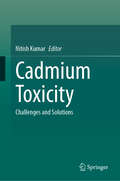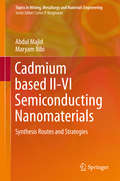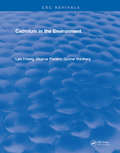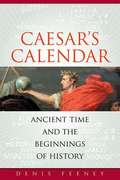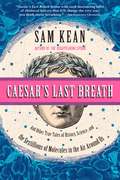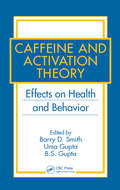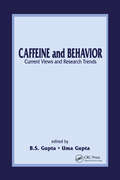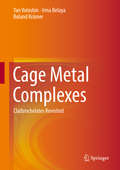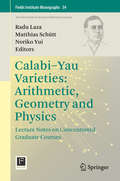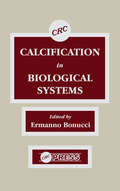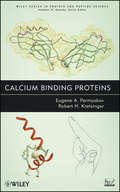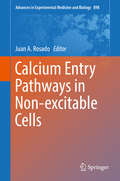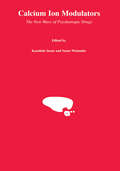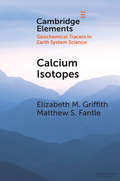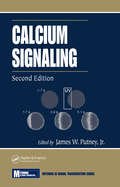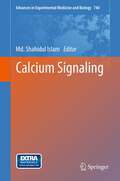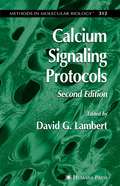- Table View
- List View
Cadmium Toxicity: Challenges and Solutions
by Nitish KumarThis book offers a comprehensive collection of review and case chapters that cover cadmium toxicity and remediation. It covers sources of cadmium contamination, its impact on human health, and prospective remediation strategies, taking a multi-disciplinary approach a focus on application of recent advanced biological technology. The chapters here bring together a diverse group of environmental science, sustainability and health researchers to address the challenges caused by cadmium contamination, explaining the routes of exposure to environmental cadmium, how cadmium is transported in ecosystems, and the health risks linked to cadmium exposure in food and the environment. This book contains two sections. The first section describes the different sources and distribution of cadmium in soil and plant ecosystems. The second section addresses sustainable cadmium toxicity mitigation strategies and potential applications of recent biological technology. This book is a valuable resource to students, academics, researchers, and environmental professionals studying cadmium contamination throughout the world.
Cadmium based II-VI Semiconducting Nanomaterials: Synthesis Routes and Strategies (Topics in Mining, Metallurgy and Materials Engineering)
by Abdul Majid Maryam BibiThis book provides technological perspective and comprehensive overview on the research efforts related to II-VI group cadmium based semiconducting nanomaterials. It describes state-of-the-art information on different synthesis methods for preparation of these materials using a variety of experimental strategies. The effects of synthesis roots on structural, thermal, mechanical, lattice vibronic, electronic, optical and carrier transport characteristics of these nano-structures are systematically analyzed. A wide target readership comprising of students, researchers, scholars, scientists, technicians, academicians, industrialists can benefit from this book, as cadmium based semiconductors possess significant research and industrial interest thanks to their innovative properties.
Cadmium in the Environment
by Lars FribergThe focus of this report is upon information essential to the understanding of the toxic action of cadmium and the relationship between dose (exposure) and effects on human beings and animals. The therapy of cadmium poisoning has not been discussed.This review on cadmium in the environment has been performed under a contract between the U.S. Environmental Protection Agency and the Department of Environmental Hygiene of the Karolinska Institute, Sweden. The report is intended to serve as a background paper for a future Air Quality Criteria document on cadmium. Therefore, particular attention has been given to information relevant for the evaluation of risks due to long-term exposure to low concentrations of cadmium. Acute effects from short-term exposure to high concentrations are dealt with briefly. In vitro studies without bearing on the main problem have not been dealt with.The report is not limited to effects from exposure via inhalation. Newly accessible information, showing that large populations may be exposed considerably via the oral route, can elucidate chronic effects of cadmium in general. Man and animals can be victims of secondary exposure through vehicles such as food and water which have been contaminated by cadmium in air.
Cadmium: From Toxicity To Essentiality (Metal Ions in Life Sciences #11)
by Astrid Sigel Roland Ko Sigel Helmut SigelVolume 11 provides in an authoritative and timely manner in 16 stimulating chapters, written by 40 internationally recognized experts from 11 nations, and supported by more than 2600 references, 35 tables, and over 100 illustrations, many in color, a most up-to-date view on the role of cadmium for life, presently a vibrant research area. MILS-11 covers the bioinorganic chemistry of Cd(II), its biogeochemistry, anthropogenic release into the environment, and speciation in the atmosphere, waters, soils, and sediments. The analytical tools for Cd determination, its imaging in cells, and the use of 113Cd NMR to probe Zn(II) and Ca(II) proteins are summarized, as are Cd(II) interactions with nucleotides, nucleic acids, amino acids, and proteins including metallothioneins. The phytoremediation by Cd(II)-accumulating plants, etc., the toxicology of Cd(II), its damage to mammalian organs, and its role as a carcinogen for humans, are highlighted.
Caesar's Calendar: Ancient Time and the Beginnings of History
by Denis FeeneyDenis Feeney investigates time and its contours as described by the ancient Romans, first as Rome positioned itself in relation to Greece and then as it exerted its influence as a major world power.
Caesar's Last Breath: Decoding the Secrets of the Air Around Us
by Sam KeanThe fascinating science and history of the air we breatheIt's invisible. It's ever-present. Without it, you would die in minutes. And it has an epic story to tell.In Caesar's Last Breath, New York Times bestselling author Sam Kean takes us on a journey through the periodic table, around the globe, and across time to tell the story of the air we breathe, which, it turns out, is also the story of earth and our existence on it.With every breath, you literally inhale the history of the world. On the ides of March, 44 BC, Julius Caesar died of stab wounds on the Senate floor, but the story of his last breath is still unfolding; in fact, you're probably inhaling some of it now. Of the sextillions of molecules entering or leaving your lungs at this moment, some might well bear traces of Cleopatra's perfumes, German mustard gas, particles exhaled by dinosaurs or emitted by atomic bombs, even remnants of stardust from the universe's creation.Tracing the origins and ingredients of our atmosphere, Kean reveals how the alchemy of air reshaped our continents, steered human progress, powered revolutions, and continues to influence everything we do. Along the way, we'll swim with radioactive pigs, witness the most important chemical reactions humans have discovered, and join the crowd at the Moulin Rouge for some of the crudest performance art of all time. Lively, witty, and filled with the astounding science of ordinary life, Caesar's Last Breath illuminates the science stories swirling around us every second.
Caffeine and Activation Theory: Effects on Health and Behavior
by Barry D. Smith Uma Gupta B. S. GuptaThe virtually universal popularity of caffeine, together with concerns about its potential pathogenic effects, have made it one of the most extensively studied drugs in history. However, despite the massive scientific literature on this important substance, most reviews have either focused on limited areas of study or been produced in popular form
Caffeine and Behavior: Current Views and Research Trends
by B. S. GuptaThe psychobehavioral effects of caffeine on humans is analyzed in this book from an experimental approach. Caffeine and Behavior: Current Views and Research Trends is unique in its emphasis on empirical research and its inclusion of articles concerning the addictive potential of caffeine. Topics covered include addiction, neurotransmission
Cage Metal Complexes: Clathrochelates Revisited
by Yan Voloshin Irina Belaya Roland KrämerThis fundamental book presents the most comprehensive summary of the current state in chemistry of cage metal complexes. After their previous book "The Encapsulation Phenomenon" (www. springer. com/978-3-319-27737-0) the authors in this book focus on the encapsulation of metal ions by different types of three-dimensional mono- and polynucleating caging ligands. Within these cage metal complexes, (metal) ions can be isolated from external factors. The book provides both a classification of the cage compounds and summaries of synthetic approaches. On that basis the authors then describe the unique chemical and physical properties and the resulting reactivity of the cage compounds, as well as practical and potential applications as potent topological drugs and prodrugs, antifibrillogenic agents, radiodiagnostic and radiotherapeutic compounds, paramagnetic probes, single-molecule magnets, electrocatalysts for hydrogen production, (photo)electronic devices, and many more. Readers will find a well-structured and concise overview, with particular emphasis on a review of synthesis and reactivity of various cage metal complexes, summarizing over 400 literature references, clearly presented in over 300 color schemes and figures.
Calabi-Yau Varieties: Lecture Notes on Concentrated Graduate Courses (Fields Institute Monographs #34)
by Matthias Schütt Radu Laza Noriko YuiThis volume presents a lively introduction to the rapidly developing and vast research areas surrounding Calabi-Yau varieties and string theory. With its coverage of the various perspectives of a wide area of topics such as Hodge theory, Gross-Siebert program, moduli problems, toric approach, and arithmetic aspects, the book gives a comprehensive overview of the current streams of mathematical research in the area. The contributions in this book are based on lectures that took place during workshops with the following thematic titles: "Modular Forms Around String Theory," "Enumerative Geometry and Calabi-Yau Varieties," "Physics Around Mirror Symmetry," "Hodge Theory in String Theory. " The book is ideal for graduate students and researchers learning about Calabi-Yau varieties as well as physics students and string theorists who wish to learn the mathematics behind these varieties.
Calcification in Biological Systems
by Ermanno BonucciCalcification in Biological Systems provides a collection of up-to-date papers regarding calcification in a variety of biological systems. The papers are not simple reviews of the literature. Each paper reflects the personal experience of the author(s) and is rich in constructive criticism and suggestions. Topics range from basic molecular processes to general structural problems in systems as different as unicellular organisms and human skeletal tissues. Because calcification is so diffuse in the animal kingdom, this book makes no attempt to achieve a conclusive synthesis of available results and current ideas. Instead, its merit lies in its ability to be useful to investigators with different scientific backgrounds and areas of interest.
Calcium Binding Proteins (Wiley Series in Protein and Peptide Science #15)
by Robert H. Kretsinger Eugene PermyakovCalcium Binding Proteins explains the unique and highly diverse functions of calcium in biology, which are realized by calcium binding proteins. The structures and physical characteristics of these calcium binding proteins are described, as well as their functions and general patterns of their evolution. Techniques that underlie the description of proteins are discussed, including NMR, circular dichroism, optical rotatory dispersion spectroscopy, calorimetry,and crystallography. The book discusses the patterns of bochmical phenomena such as calcium homeostasis, mineralization, and cell signaling that involve specific proteins. It summarizes ongoing research and presents general hypotheses that help to focus future research, and also provides a conceptual framework and a description of the underlying techniques that permits someone entering the field to become conversant.
Calcium Entry Channels in Non-Excitable Cells (Methods in Signal Transduction Series)
by Juliusz Ashot Kozak James W. Putney Jr.Calcium Entry Channels in Non-Excitable Cells focuses on methods of investigating the structure and function of non-voltage gated calcium channels. Each chapter presents important discoveries in calcium entry pathways, specifically dealing with the molecular identification of store-operated calcium channels which were reviewed by earlier volumes in the Methods in Signal Transduction series. Crystallographic and pharmacological approaches to the study of calcium channels of epithelial cells are also discussed. <P><P> Calcium ion is a messenger in most cell types. Whereas voltage gated calcium channels have been studied extensively, the non-voltage gated calcium entry channel genes have only been identified relatively recently. The book will fill this important niche.
Calcium Entry Pathways in Non-excitable Cells (Advances in Experimental Medicine and Biology #898)
by Juan A. RosadoCalcium entry pathways in non-excitable cells presents a concise synthesis of thoughtfully selected topics covering from the different calcium entry mechanisms in non-excitable cells to the cellular microdomains and organelles regulating the calcium entry process. Particular attention is given to the fascinating group of ion channels involved in different calcium entry pathways as well as the emerging role of these channels in human disease. Calcium entry is an essential mechanism for cellular function in non-excitable cells. In general, two main calcium entry pathways exist in non-excitable cells: one pathway, named store-operated calcium entry (SOCE) requires store depletion and the second pathway is regulated by receptor occupation, but independently on calcium store depletion. The search for the molecular components of calcium entry has identified the stromal interaction molecule 1 (STIM1), as the calcium sensor of the intracellular calcium stores, and Orai as well as TRP channels as the calcium-permeable channels located in the plasma membrane. The location, interactions and function of these channels are finely regulated by a number of scaffolding proteins, membrane microdomains and cellular organelles that fine tune the amount of calcium entering the cell. Cutting-edge and user-friendly, this volume presents relevant background information, critical analysis of the current observations and directions for future research. The book is intended for basic scientists specializing in cellular biology or ion transport, as well as for biomedical researchers.
Calcium Handling in hiPSC-Derived Cardiomyocytes: Calcium Handling In Hipsc-derived Cardiomyocytes (SpringerBriefs in Stem Cells)
by Lee Yee-Ki Siu Chung-WahCalcium is crucial in governing contractile activities of myofilaments in cardiomyocytes, any defeats in calcium homeostasis of the cells would adversely affect heart pumping action. The characterization of calcium handling properties in human induced pluripotent stem cell-derived cardiomyocytes (iPS-CMCs) is of significant interest and pertinent to the stem cell and cardiac regenerative field because of their potential patient-specific therapeutic use.
Calcium Ion Modulators: The New Wave of Pschotropic Drugs
by Kazuhide Inoue Yasuo WatanabeThis title primarily focuses on the functional mechanisms and roles of Ca2+ channels in the central nervous system, and the effects of Ca antagonists on cytosolic CA2+ by blocking voltage sensitive channels. These findings are an important contribution to understanding the mechanisms of brain dysfunctions, including Alzheimer's disease, cerebral ischemia and affective disorders, as well as the effects of cytosolic CA2+ modulators on neuronal cell death. In addition the results of clinical trials are reported using typical and atypical Ca antagonists in the treatment of neuropsychiatric diseases.An essential reference to some of the most current and vital research into Ca antagonists as therapeutic agents, this monograph is invaluable for all clinical and pre-clinical researchers active in the multidisciplinary fields of neuroscience, including: psychopharmacology, molecular biology, behavioral pharmacology, neuropharmacology, and electrophysiology and immunology. Investigators of Ca2+ dynamics and brain dysfunction especially will find this book useful in the development of novel drugs to treat neuropsychiatric diseases.
Calcium Isotopes (Elements in Geochemical Tracers in Earth System Science)
by Elizabeth Griffith Matthew Fantle<p>Precise measurements of the calcium (Ca) isotopes have provided constraints on Ca cycling at global and local scales, and quantified rates of carbonate diagenesis in marine sedimentary systems. Key to applying Ca isotopes as a geochemical tracer of Ca cycling, carbonate (bio)mineralization, and diagenesis is an understanding of the impact of multiple factors potentially impacting Ca isotopes in the rock record. These factors include variations in stable isotopic fractionation factors, the influence of local-scale Ca cycling on Ca isotopic gradients in carbonate settings, carbonate dissolution and reprecipitation, and the relationship between the Ca isotopic composition of seawater and mineral phases that record the secular evolution of seawater chemistry.</p>
Calcium Oxalate in Biological Systems
by Saeed R. KhanWritten by leaders in their fields, Calcium Oxalate in Biological Systems comprehensively discusses current information about the importance of this compound in animals, plants, fungi, and microorganisms. Both in vivo and in vitro methods of crystallization as well as crystallization systems are discussed. Researchers who pioneered the field contribute their invaluable knowledge for the first time about oxalate bacteria and their importance. This is an essential reference for both plant and animal scientists concerned with human and animal kidney disease.
Calcium Phosphate Nanocoatings for Bone Regeneration (Tissue Repair and Reconstruction)
by Besim Ben-Nissan Andy H. ChoiThis book provides in-depth assessment on the latest clinical advances in multifunctional calcium phosphate nanocoatings and its influence on bone regeneration and early healing following implantation. A greater emphasis will be placed on the use of nanocomposite coatings to deliver biological materials such as mesenchymal stem cells, growth factors, bone morphogenetic and extracellular matrix proteins, and pharmaceutics such as simvastatin to improve and promote bone growth as well as reducing the timeframe needed for implant integration in both healthy and osteoporotic patients. The content of the book caters to clinical practitioners and researchers working in the field of biomaterials for bone regeneration.
Calcium Signaling
by James W. PutneyThe first edition of James Putney's Calcium Signaling offered readers a comprehensive view of the fascinating diversity of technologies that the new field of calcium signaling employed. And while that work is still regarded as a premier text on the basics of calcium signaling, progress has been so dramatic that an update is now required.In Cal
Calcium Signaling (Advances in Experimental Medicine and Biology #740)
by Md. Shahidul IslamCalcium signaling contains a unique selection of chapters that cover a wide range of contemporary topics in this ubiquitous and diverse system of cell signaling. This book has the flavor of a primary text book, but it is much more than that. It covers topics ranging from the fundamental aspects of calcium signaling to its clinical implications, in a thoughtful and comprehensive way. It discusses cutting edge researches, and critical issues at depth, and it presents many testable hypotheses for future research. It includes the theoretical and the methodological topics as well as topics related to mathematical modeling, and simulations. If you want to read about calcium signaling in different mammalian cells, oocytes, Zebrafishes, and even in plants, in one and the same book, then this book will not disappoint you. From the beginners to the experts in the field of calcium signaling, everybody will find something useful in this very timely book.
Calcium Signaling In Airway Smooth Muscle Cells
by Yong-Xiao WangThis book explores the role calcium signaling plays in cellular responses in almost all types of cells including airway smooth muscle cells. This universal signaling may result from extracellular calcium influx and/or intracellular calcium release, which are precisely controlled and regulated by ion channels, exchangers and/or transporters on the plasmalemmal or sarcoplasmic reticulum membrane. First, several chapters detail calcium release channels (ryanodine receptors and inositol trisphosphate receptors), voltage-dependent potassium channels, transient receptor potential channels, Orai channels, calcium-activated potassium channels, and calcium-activated chloride channels. Well-characterized sodium-calcium exchangers, voltage-dependent calcium channels, and calcium pumps are described also in depth over many chapters. Ca2+ signaling can be expressed in Ca2+ sparks, waves, oscillations, and global changes in intracellular Ca2+ concentration. Calcium in subcellular compartments (cytosol, sarcoplasmic reticulum, mitochondria, and caveolae) also exhibit dynamic crosstalk. Many molecules including FK506 binding proteins, cyclic adenosine diphosphate ribose, reactive oxygen species, RhoA kinases, caveolin and integrins can modify and induce spatial, temporal and compartmental variations of calcium signaling. In addition, calcium signaling can exhibit sex hormone- and age-dependent changes. A number of chapters are dedicated to covering these diverse formats, spatiotemporal characteristics, multifaceted network and mathematical modeling of Ca2+ signaling. Neurotransmitters, hormones, growth factors, inflammatory cytokines, and other stimuli may lead to multiple cellular responses by inducing Ca2+ signaling in airway smooth muscle cells. Increasing evidence suggests that Ca2+ pumps and canonical transient receptor potential channels are essential for airway smooth muscle remodeling. Accordingly, several chapters summarize recent advances in the studies of the key role of calcium signaling in physiological cellular responses as well as the development of asthma, chronic obstructive pulmonary disease and other respiratory disorders.
Calcium Signaling Protocols (Methods in Molecular Biology #114)
by David G. LambertDavid Lambert and a panel of leading authorities present a wide range of experimental protocols for studying Ca2+ signaling. These optimized techniques cover the more common applications, including 45Ca2+ flux measurements, and basic fluorometric technology, as well as more sophisticated methods, including confocal microscopy and subcellular Ca2+ imaging. There are also methods-largely based on fluorescence measurement-to determine Ca2+ channel activity and the release of Ca2+ from intracellular stores. Calcium Signaling Protocols offers today's researchers readily reproducible laboratory methods that make it possible to examine the calcium signaling process in detail in a range of cells of animal and plant origin.
Calcium Signaling Protocols, 2nd Edition (Methods in Molecular Biology #312)
by David G. LambertNow extensively updated and expanded, Calcium Signaling Protocols, Second Edition continues the excellence of the highly regarded first edition. New to this edition are chapters on the electrophysiological measurement of Ca2+ channel activity, enhanced coverage of confocal microscopy, and practical tutorials on two of the most common industrial high-throughput machines, the Fluorometric Imaging Plate Reader (FLIPR), and the FlexStation. All experimental chapters provide readily reproducible techniques for measuring the many facets of Ca2+ signaling. The protocols follow the successful Methods in Molecular Biology series format, each offering step-by-step laboratory instructions, an introduction outlining the principles behind the technique, lists of the necessary equipment and reagents, and tips on troubleshooting and avoiding known pitfalls. Authoritative and up-to-date, Calcium Signaling Protocols, Second Edition provides for novice and expert researchers alike both theoretical and practical information for the optimal design and performance of studies of intracellular Ca2+ regulation
Calcium Signaling Protocols, 3rd Edition (Methods in Molecular Biology #937)
by David G. Lambert Richard D. RainbowThe regulation of intracellular Ca2+ has continued to be a powerful area of study since the publication of the first and second editions of Calcium Signaling Protocols, and the developments in the field have also, naturally, continued. With the third edition, expert contributors explore some of the exciting new molecular techniques that have both enabled new studies of intracellular Ca2+ regulation and provided much new information on processes. Comprised of five main section, the book covers theoretical and very simple suspension-based fluorimetric assays, specialist measurement systems, measurement of channel activity, measurement of store release, as well as specialist measurement techniques which include targeted probes, using G-protein chimeras to force Ca2+ signalling for screening, and genetically encoded sensors. Written in the highly successful Methods in Molecular BiologyTM series format, chapters include introductions to their respective topics, lists of the necessary materials and reagents, step-by-step, readily reproducible laboratory protocols, and tips on troubleshooting and avoiding known pitfalls. Updated and accessible, Calcium Signaling Protocols, Third Edition will be a valuable reference for all those contemplating a move into the study of intracellular Ca2+.
